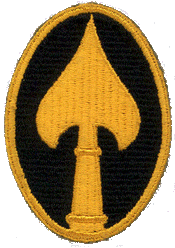
OSS Insignia
The Office of Strategic Services (Or OSS) was the intelligence service of USA during WWII. It is considered the precursor to the Central Intelligence or CIA.
Creation[]
Before the creation of the OSS (the equivalent of British Secret Intelligence Service), The affairs of the intelligence service were distributed among the different departments of government United States without any coordination. Thus, for example, the Army and Navy used different codes to decipher the secret messages.
President Franklin Delano Roosevelt concerned about the shortcomings of the intelligence service of the United States, and advised by the Canadian military and spy William Stephenson instructed his friend William Joseph Donovan, A veteran of the World War I the creation of an intelligence service. His work was compiled in the "Memorandum of Establishment of Service of Strategic Information", then Donovan was named Coordinator of Information "in July 1941. Thus was established the Office of Strategic Services, due to an order issued by Roosevelt in June 13 of 1942, Thinking at first to collect and analyze information of the General Staff of the United States, and conduct special operations not assigned to other agencies.
Action During the War[]
During WWII, the OSS has undertaken several actions. On the one hand, was responsible for all intelligence, but always on the domestic front, because outside the U.S. had no jurisdiction in the world (the FBI acted, for example, be made on the Latin America). But that did not stop the OSS articulate, train and supply resistance movements, including in other countries that were strategically favorable to the U.S in the war, as the army of Mao Tse-tung and the Viet Minh.
The OSS also recruited one of the most important spies of World War II, the German Fritz Kolbe. In this sense, propaganda and subversion were constant activities of the organization. The OSS purchased encoderd soviet material coming from the Finland, Sold by the military of Finland 1944. The Secretary of State Edward Stettinius Jr, protested that this violated a guideline of Roosevelt, who agreed with the Soviet Union not to investigate codes encoded in both countries.
One of the greatest achievements of the OSS during the war was its penetration of Germany. The organization was responsible for training German and Austrian spies in that country. Some of these agents were exiled communists and socialists, or simply anti-Nazi forces. Managed to train no less than 12,000 agents.
OSS to CIA[]
A month and a half after winning the war, around September 20 of 1945 the OSS was disbanded by President Harry S. Truman. Thus, during the months following, the functions of OSS were the Departments of State and War. The State Department took issue with the section Research and Analysis, Which was renamed Internal Services Research and Intelligence (Interim Research and Intelligence Service and, IRIS) directed by Alfred McCormack. The War Department took over the Secret Intelligence (Secret Intelligence, SI) and X-2, for which were created a special agency, the Strategic Services Unit or SSU. Secretary of War appointed Brigadier General John Magruder as supervisor of the dissolution of OSS, to preserve the secrecy of their actions.
Already in January 1946, president Truman created the Central Intelligence Group (CIG), which is the direct precursor to the CIA. The activities and functions of the SSU were transferred to the IGC, which renamed it the Office of Special Operations (OSO). In 1947, A National Security Act established America's first intelligence agency in times of peace, CIA, Which assumed all the functions of the OSS.
Branches[]
|
|
Detachments[]
- OSS Detachment 101 — Burma
- OSS Detachment 202 — China
- OSS Detachment 303 — New Delhi, India
- OSS Detachment 404 — attached to British South East Asia Command in Kandy, Ceylon
- OSS Detachment 505 — Calcutta, India
US Army units attached to the OSS[]
Facilities[]
Prince William Forest Park, then known as Chopawamsic Recreational Demonstration Area, was the training camp of the OSS betwee 1942 and 1945. It was divided into two areas: "Area C" of 24 square kilometers, which was used for training of media groups and the "Area A" which was used by the Operations Group. Moreover, the Catoctin Mountain Park, the current location of Camp David was the "Area B" of training.
There were other areas of training of the OSS. For example, installations of Catalina Island Marine Institute at Santa Catalina Island were formed in part by former OSS training facilities.
See also[]
The original article can be found at Office of Strategic Services and the edit history here.